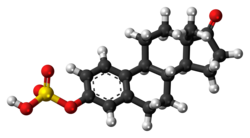Top Qs
Timeline
Chat
Perspective
Estrone sulfate (medication)
Chemical compound From Wikipedia, the free encyclopedia
Remove ads
Estrone sulfate (E1S) is an estrogen medication and naturally occurring steroid hormone.[1] It is used in menopausal hormone therapy among other indications.[1][2] As the sodium salt (sodium estrone sulfate), it is the major estrogen component of conjugated estrogens (Premarin) and esterified estrogens (Estratab, Menest).[1][3] In addition, E1S is used on its own as the piperazine salt estropipate (piperazine estrone sulfate; Ogen).[1][3] The compound also occurs as a major and important metabolite of estradiol and estrone.[1] E1S is most commonly taken by mouth, but in the form of Premarin can also be taken by parenteral routes such as transdermal, vaginal, and injection.[1][2]
Remove ads
Medical uses
E1S is used in menopausal hormone therapy among other indications.[1][2]
Pharmacology
Summarize
Perspective
Pharmacodynamics
E1S itself is essentially biologically inactive, with less than 1% of the relative binding affinity of estradiol for the estrogen receptors (ERs), ERα and ERβ.[7] The compound acts as a prodrug of estrone and more importantly of estradiol, the latter of which is a potent agonist of the ERs.[1] Hence, E1S is an estrogen.[1]
Pharmacokinetics
E1S is cleaved by steroid sulfatase (also called estrogen sulfatase) into estrone.[5] Simultaneously, estrogen sulfotransferases transform estrone back into E1S, which results in an equilibrium between the two steroids in various tissues.[5] E1S is thought to serve both as a rapidly-acting prodrug of estradiol and also as a long-lasting reservoir of estradiol in the body, which serves to greatly extend the duration of estradiol when used as a medication.[1][8][9]
When estradiol is administered orally, it is subject to extensive first-pass metabolism (95%) in the intestines and liver.[10][11] A single administered dose of estradiol is absorbed 15% as estrone, 25% as E1S, 25% as estradiol glucuronide, and 25% as estrone glucuronide.[10] Formation of estrogen glucuronide conjugates is particularly important with oral estradiol as the percentage of estrogen glucuronide conjugates in circulation is much higher with oral ingestion than with parenteral estradiol.[10] Estrone glucuronide can be reconverted back into estradiol, and a large circulating pool of estrogen glucuronide and sulfate conjugates serves as a long-lasting reservoir of estradiol that effectively extends its terminal half-life of oral estradiol.[10][11] To demonstrate the importance of first-pass metabolism and the estrogen conjugate reservoir in the pharmacokinetics of estradiol,[10] the terminal half-life of oral estradiol is 13 to 20 hours[12] whereas with intravenous injection its terminal half-life is only about 1 to 2 hours.[13]
Estrogen sulfates like estrone sulfate are about twice as potent as the corresponding free estrogens in terms of estrogenic effect when given orally to rodents.[14] This in part led to the introduction of conjugated estrogens (Premarin), which are primarily estrone sulfate, in 1941.[14]
Metabolic pathways of estradiol in humans
|
Remove ads
Chemistry
E1S, also known as estrone 3-sulfate or as estra-1,3,5(10)-trien-17-one 3-sulfate, is a naturally occurring estrane steroid and a derivative of estrone.[15] It is an estrogen conjugate or ester, and is specifically the C3 sulfate ester of estrone.[15] Salts of E1S include sodium estrone sulfate and estropipate (piperazine estrone sulfate).[15][1][3]
References
Further reading
Wikiwand - on
Seamless Wikipedia browsing. On steroids.
Remove ads



